How to Stay Healthy While Traveling in India
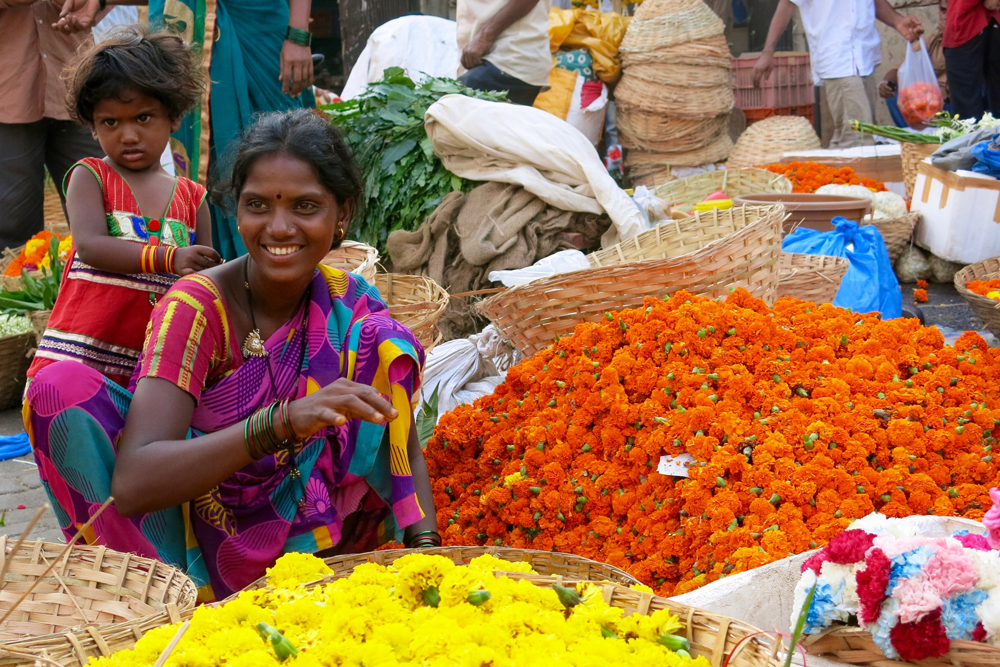 Flower market, Mumbai. Photo: India Beat
Flower market, Mumbai. Photo: India Beat When you tell someone you’re going to India, it’s a good bet their first response will be something like “Don’t drink the water!” or “Get ready for Delhi belly.” And that’s unfortunate, because travelers should focus their energies on the more enjoyable problems that a trip to India poses—such as which parts of the huge country to visit, how to bypass lines at its many famous temples and palaces, where to sample its myriad different cuisines and dishes, and how to cram as many activities and experiences into one vacation. Still, concern about health and food safety continues to loom large for tourists heading to India.
“It’s one of the questions people are worried about: getting sick and how to avoid it,” says Victoria Dyer, an India travel specialist on Wendy’s WOW List. “Some people, and typically those who already have a food intolerance or are sensitive to a change of diet, will ask for advice about ‘Delhi belly’ and how to eat their way healthily round India.” Victoria and her husband, Bertie, lived in Jaipur for eight years and have been in love with the country for many more. Luckily, things have changed in recent years, she says. “Ten years ago it was almost a given that travelers would get sick. But now hygiene has really improved, and it’s pretty unusual that we have an issue with anyone becoming ill.”
She attributes the improvement to India’s tourism boom. “There are luxury five-star hotels that realize that food safety has to be a priority,” Victoria says. “In the past few years there’s been a real drive to maintain standards to a much higher level.” She adds that these days, “Indian food is something that people are really excited about; we have some phenomenal restaurants here that are gaining an international reputation.” To help guide travelers to restaurants of the highest culinary and sanitary standards, she provides recommendations to her and her husband’s favorite eateries around the country. “We recommend places we know personally, that we’ve been to, that we’ve eaten at ourselves, and places that provide different levels of experience,” she says. “People might want to go where there’s a celebrated chef and others might want to have a much more local experience.”
Sanjay Saxena, another of Wendy’s WOW List travel specialists for India, agrees that things are changing in India. “Food quality in the last decade has improved tremendously,” he says. “Loads of restaurants now provide purified water through a central system to their kitchens.” Oberoi and Taj properties have this kind of system, he says. Smaller private hotels often do not, though, so he warns travelers to avoid cold salads, especially the cucumbers, tomatoes and raita that are frequently provided on buffets. These are most likely rinsed in tap water (or, in the case of raita, contain raw vegetables that were rinsed in tap water) and could leave you in distress. However, he added, “Indian food is generally ‘well done’ boiled/simmered for minutes if not hours, killing all bacteria, and so always safe to eat. But if food is kept sitting then it can be an issue.”
Of course, it never hurts to err on the side of caution. That’s why we’ve compiled this list of tips and strategies to lower your chance of getting sick. And since feeling good is not only about your belly but about your entire body (the sights, sounds, smells, climate, and pace of India can be overwhelming), we’ve included some mental-health suggestions as well. Knowing these things will help keep you at 100 percent.
For physical health
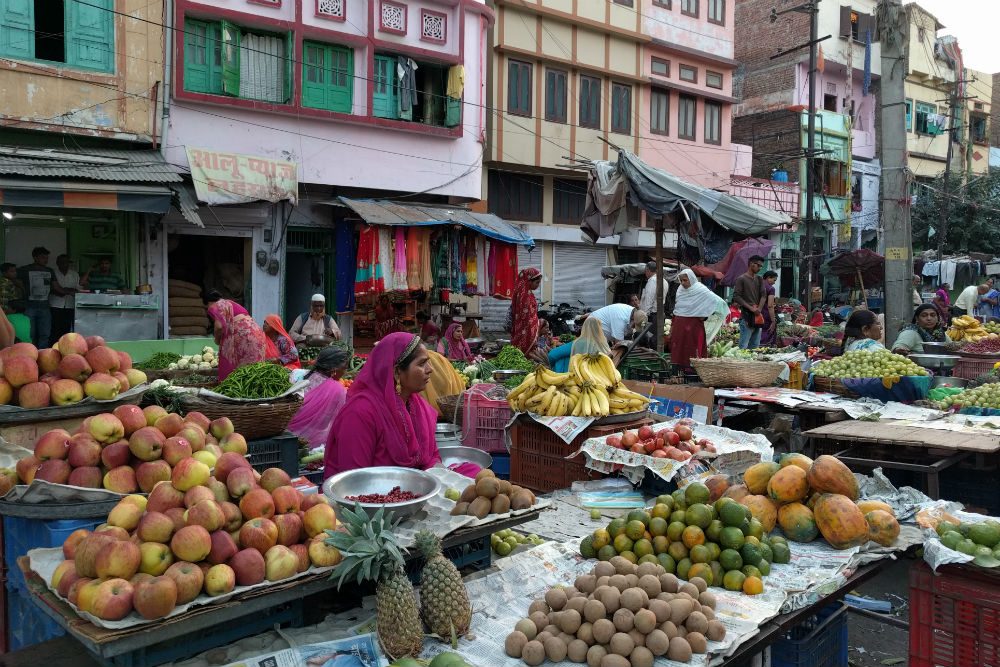
Only eat fresh fruit you wash, cut and peel yourself. And wash it with bottled water. Photo: Billie Cohen
•Bring more hand sanitizer than you think you’ll need—and use it.
Have a small bottle on you at all times, so you can easily clean your hands before you eat or drink, and after the bathroom. Wipes are also useful for cleaning the dust off any bottles of water or packages of snacks you might buy from street vendors.
•Buy bottled water and listen for the “crack.”
Indians are master recyclers and reuse everything. As you travel around, you’ll see locals pouring water into their mouths without letting the bottles touch their lips; this is because they reuse and share bottles. Visitors, of course, should buy sealed bottled water only; drinking anything from the tap could result in sickness. If you don’t hear the plastic safety ring crack open when you twist the bottle—or if you don’t hear the soda fizz when you open it—get a new one. In the pre-trip notes he writes to his travelers, Sanjay goes even further, “Drink only bottled water, sodas, beer, coffee, or tea,” he writes. And “In hotel rooms you may be provided with a pitcher or thermos of water, never drink this before sterilizing the water!”
•Use this fail-safe tooth-brushing strategy.
Tooth brushing is such an ingrained habit that it’s easy to make a mistake and revert to muscle memory—you could find yourself scooping water to your mouth or running your brush under the tap before you even realize you’re doing it. The fail-safe solution I use is to always hold my toothbrush in one hand, and my bottle of water in the other—I don’t put either down until I’m through the entire process. I do this because if both hands are full, I can’t unthinkingly turn on the tap. (And if it wasn’t clear: Don’t brush your teeth, or even open your mouth, in the shower.)
•Avoid cut or peeled fresh fruit.
If it’s been cut open and rinsed in local water, that’s the same as drinking local water. Closed fruit, such as oranges and bananas, are usually okay (but use your own judgment). Wipe them down and wash them with bottle water, and sanitize your hands before peeling them. (Usually the cut and peeled fresh fruit served in five-star hotels is A-OK.)
•Say no to ice.
Many high-end hotels and restaurants are now using filtered water for ice (and some other places say they are but aren’t), but if you’re not sure, go without. In a lot of cases, your drinks will still be cold. In fact, when you order a soda or a beer in India, the waitstaff will usually bring the closed bottle to your table so that you can approve of its temperature before they crack it open in front of you.
•Carry plastic straws.
Pack some plastic straws (even better if they’re individually wrapped), and carry a few with you every day. This may not be the most eco-friendly tip, but straws are very useful to have if you’re drinking from a can or a bottle that might have been sitting in unfiltered ice—this way, you don’t have to touch your lips to them.
•Bring tissue packs and anti-bacterial wipes.
Buy a bunch of small tissue packs and wet wipes and always have some in your day bag (bandanas are invaluable too). They come in handy as toilet paper, brow moppers, dust masks, and napkins. You’ll also want to wipe down bottles and snacks that you buy from street vendors. There’s no point in sanitizing your hands if the bag of chips you’re about to rip open is covered in grime.
•Wipe down your gadgets at the end of each day.
Even if you’re sanitizing your hands before every meal and after every bathroom run, they’re still going to be filthy by the end of the day. Once you remember that you’ve been grabbing your camera and phone in and out of your bag all day long with those hands, you’ll know why it’s a good idea to run a sanitizer wipe over them (be careful of screens).
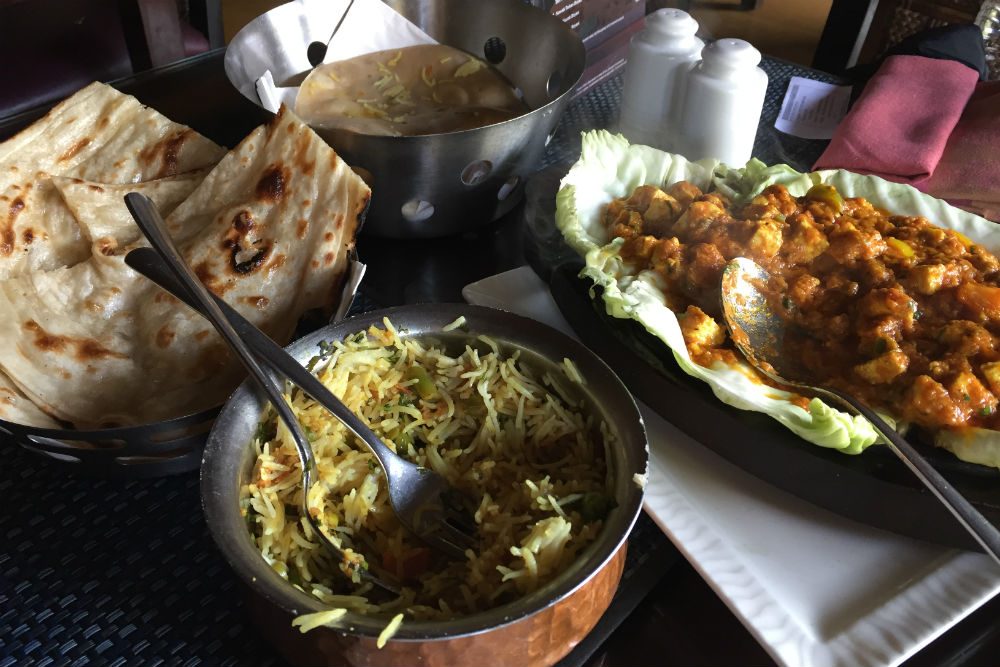
The food in India is delicious—and exciting because the cuisine varies from region to region. Start out slow (and possibly vegetarian) to acclimate to the hotter spices and new flavors. Photo: Colleen Brennan
•Don’t be embarrassed to ask for mildly spiced food.
Indian food prepared in India is spicier than you’re used to—even if you like spicy cuisine. When you order, ask for no (or little) spice. You can increase the heat as you acclimate.
•Be careful what you order where.
Don’t order seafood if you’re miles away from the sea, since refrigeration might not be great. And keep in mind that, even if everything is clean and cooked properly, your stomach needs to adjust to the new foods and flavors. For example, paneer (an Indian cheese) can be harder on your digestive system than cheeses at home, and it might not be fresh or high quality in every restaurant. Meats might not agree with you even though you eat meat back in the States, so consider a vegetarian diet (very easy to do here) as you ease into the new spices and flavors. Above all, trust your instincts, and listen to your body. “If you feel a bit nauseous, starve yourself for 24 hours,” says Victoria. “Just rice or yogurt and drink loads of water and allow yourself to get better. A lot of people are excited about the food so they can’t resist it,” she adds with a laugh.
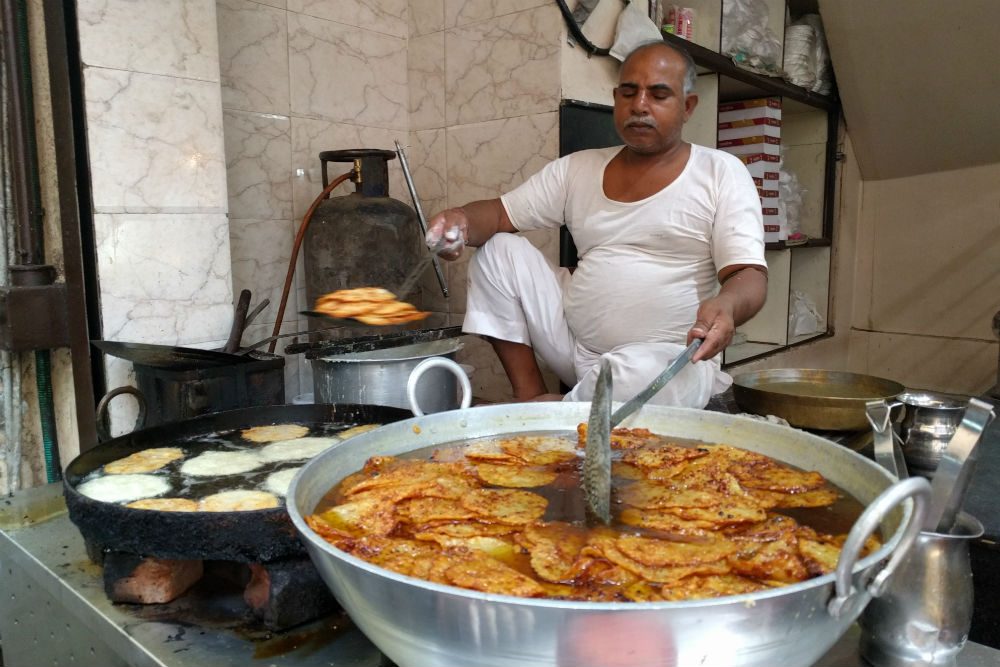
Street food can be tempting in India, but it can also be hard on your stomach. Play it safe and avoid it. Photo: Billie Cohen
•Steer clear of street food.
You’ve heard this one before, but it bears repeating. You will see a lot of street food, fresh fruit, and snacks as you travel in India. Some of it may be offered to you by friendly vendors or even by local friends, and you might feel awkward declining. But it’s better to feel awkward than to feel sick. As Sanjay tells his travelers before their trips, “No matter how appealing the smell and look, DO NOT eat food from street vendors, especially food that has been sitting.”
•When in doubt, drink a Coke.
They say Coca-Cola can strip rust off of metal. If that’s true, then it can definitely kill any bugs you might accidentally ingest. Yes, this one is more of an old wives’ tale, but I swear by it. I’ve chased many a questionable meal (and an unfortunate tooth-brushing mistake) with a can of Coke, and didn’t get sick. Who knows if it was the Coke that saved me, but I was pleasantly surprised (and validated) when my guide in Pushkar said that he recommends the same cure-all to his guests.
•You can become dehydrated before you even realize it, so drink regularly.
The rule is: If you feel thirsty, you’re already dehydrated. Carry water on you all the time, and avoid too much caffeine. You can easily purchase electrolyte powder at drug stores here, which tastes like a salty-sweet fruit drink. Pour one packet in a liter of water to help prevent or cure dehydration.
•Respect the sun.
The sun is incredibly hot and intense here, even in winter. Bring a wide-brimmed hat and sunblock, and wear both every day. I attach my hat to my bag with an alligator clip (or sometimes wear a hat with a string) so I can take it on and off easily when I walk in the shade. I may not look stylish, but I’m also not sunburned, so I consider that a win.
•Bring closed-toe shoes.
Streets are dirty in India. Sometimes it’s the gritty dust or desert sand of normal life in a dry climate, but sometimes it’s grime, garbage, and mysterious puddles. So make sure you have at least one pair of closed shoes with you.
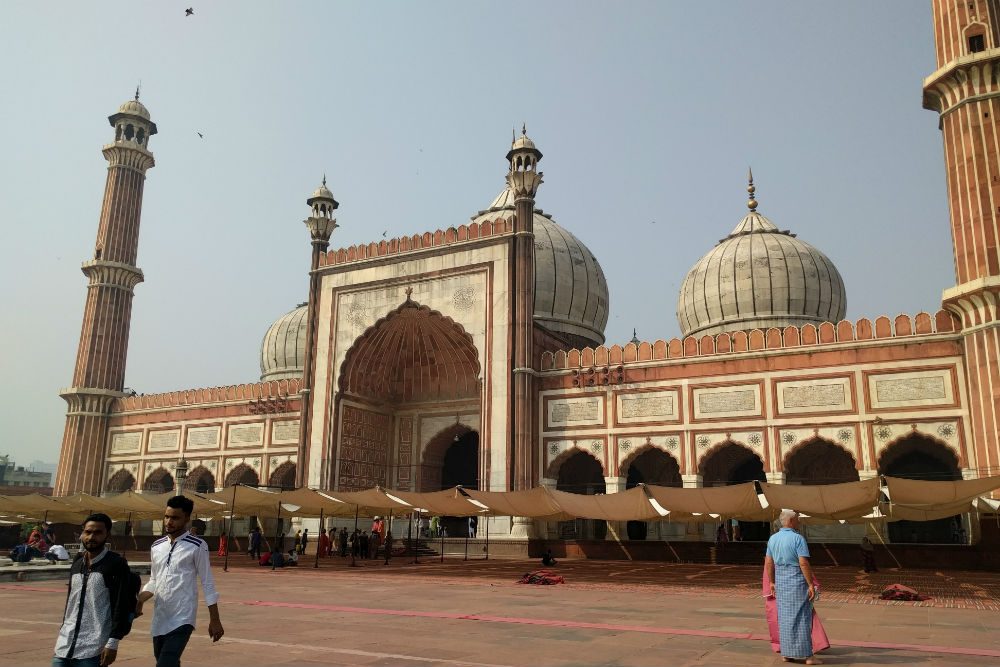
Many temples and holy monuments, such as the Jama Masjid in Delhi, require you to take off your shoes. Carry socks to protect your feet from hot stones and dirty floors. Photo: Billie Cohen
•Carry a pair of socks in your day bag if you’re not already wearing them.
You’ll be removing your shoes quite a bit as you visit temples and holy ghats (riverside staircases used for bathing), but some sites allow you to keep your socks on. Ask even if it’s not indicated on the signage. You’ll want your feet covered in some places because of dirt and/or hot stones. If you do take off your shoes and socks, this is another instance when sanitary wipes are useful. You can wipe off your feet before putting your socks and shoes back on.
•Take your malaria pills with a big meal somewhat early in the day
Consult your travel doctor about what medications to take in India, but you will likely need to be on malaria pills—and you’ll want to take them every day with food. Breakfast was the easiest time for me, since that was usually a big meal. When Wendy was in Africa, her family didn’t eat much breakfast and chose to take their malaria pills at lunch instead of at dinner. That’s because if they forgot at lunchtime, they could take them at dinnertime with little negative repercussion, whereas if they forgot at dinnertime, that would result in skipping a day, which could have great negative repercussion.
•Take advantage of expert knowledge.
Planning a rewarding and comfortable trip through India requires a deep understanding of the country, its culture, its complexity, and its changing tourism infrastructure. You definitely want to have someone you trust working on organizing the right accommodations and experiences for you. For example, the annual Pushkar Camel Fair is a fascinating whirlwind of sights, sounds, crowds, and sand—but it is also challenging and overwhelming to navigate. When I traveled there, Sanjay knew exactly which hotel would not only be the most sanitary and the safest, but would also provide a much-needed respite from the sensory overload of the fairground.
•If you decide you want Western food, go to a place that serves a lot of Western expats.
Even if you love Indian food, at some point you will probably want a break from curry, rice, and decadent buttered naan. When that time comes, choose a restaurant with a good track record of preparing food to Western standards (look for the expats). The food will be safer and more delicious.
For mental health

Travel specialists can guide you to delicious, safe, and beautiful restaurants all over India, like Victoria’s recommendation of Bar Palladio in Jaipur. Photo: Billie Cohen
•Flip your thinking about the noise: Recognize that horns are there to make you safe.
You will hear a lot of honking in India, and it will be loud. Tuk tuks, rickshaws, cars, beautifully decorated trucks, scooters, pedestrians, cows—they all jockey for space on the same narrow roads, and the only rule about driving seems to be that there are no rules. At first you may find that the constant honking puts you on edge, but for me that stress dissipated when I realized that in India, the horn is not an instrument of road rage—it’s actually a way to be considerate of others. It’s the way drivers tell each other, “Hey, I’m coming up behind you, and I want to make sure you see me.” Tweaking your perspective on that is likely to help you tolerate it better.
•Don’t give money to beggars, no matter their age and adorableness.
Beggars of all ages will approach you in various places in India. In Jaipur they knocked on our car windows; in Pushkar, smiling playful kids trailed us around the fairground chanting, “Money, money!” The poverty is upsetting, but as India experts will tell you, handing over your money is not the answer. As hard as it may be on your heart, the best thing to do is to ignore them or firmly say “nay” and keep walking. They won’t try to open the door, they won’t become aggressive, and they will eventually walk away. This is one of many reasons why you want to hire the best local guides possible. I was very aware of how much mine were looking out for me in these times, and I always felt that I was safe. They will usually clear the way with a friendly word before it even becomes a problem.
•Ignore touts completely.
Touts will follow you in their attempt to convince you to buy things at monuments and in the streets. You do not need to say no, or no thank you, or anything at all—in fact, I learned from a guide that if you say “no” they are likely to interpret that as an invitation to haggle. So just keep walking, and they will fall away. Again, guides will have your back and will shoo them away if necessary. To be honest, though, I never felt threatened at any time. People here are persistent but not aggressive, and they smile a lot. So when I did have interactions, they often ended with mutual grins and laughter.

Our guide for the Pushkar Camel Fair knew to bring us back to the fairground late in the day so that we could avoid the hottest sun and also catch camel trades in action. Photo: Billie Cohen
•Leave room in your itinerary to take time off between noon and 3 p.m..
Give yourself a break to recharge during the hottest part of the day, when you’d be uncomfortable outside anyway (especially at monuments where there’s little shade) and inside stuffy museums (which usually have no air-conditioning). Instead, give yourself permission to take a break: Try a long leisurely lunch or relax at your hotel. Then head back out close to sunset, when the weather will be cooler, the light will be more beautiful for photos, and you will be refreshed and ready to enjoy the evening. Smart guides know this and will make sure your activities take place at the optimal times. For example, Kapil, the guide Sanjay assigned me for the desert-based Pushkar Camel Fair, knew to take us out to the fairgrounds in the early mornings and early evenings, with a long cooling midday break—not only because we’d be more comfortable, but because that’s when we’d have the best chance of seeing camel and horse trades take place, an integral and very interesting part of the fair. In the bustling city of Jaipur, timing was just as important. Virendra, our guide for Victoria’s VIP shopping tour through Jaipur, timed our afternoon perfectly so that we ended right at sunset in a quaint, boutique-filled palace, where we could browse a bit more and then unwind with cocktails and dinner al fresco.
•Look for the women.
Personal safety is another question that travelers often ask Sanjay and Victoria about before they get to India. Can we walk around at night? Should we avoid certain places if we’re alone? You’re not any more or less safe in India than in Western cities; crime happens everywhere, and if you follow the usual common-sense rules (lock your purse, make sure someone always knows where you are, don’t accept open drinks from strangers, etc.) you’ll be fine. But there is one especially helpful tip I learned from a guide: Look for the women, he said. If you’re out at night and there are still Indian women buzzing about, that’s a clue that you’re in a good neighborhood at a good time of night.
•Pack a loofah, body puff, or fast-drying washcloth.
This may not seem like it would have such a big impact on how you feel but, trust me, it will. India is dusty and hot. And did I mention it’s dusty and hot? On top of the grime and sweat you’ll build up just from touring around, you’re going to be coated in sunblock and bug spray by the end of each day. A scrub, especially for your tired and dirty feet, will feel like a luxury, and it takes up virtually no space in your luggage.

If it’s night time and women are still out shopping and strolling, it’s usually still appropriate to be out shopping and strolling yourself. Photo: Billie Cohen
If you do get sick
If you do get sick, there is plenty of help available. “Healthcare too has greatly improved (not just quality, but more importantly access) in the [past] two decades,” says Sanjay, “and now travelers can find a qualified doctor quite easily across India.” Victoria likes to remind travelers that “calling a doctor in India is not the same as in America. It’s not as expensive and your hotel will be able to get you help easily. A stomach bug is usually cleared up very quickly.” So don’t try to be a hero and suffer through it, she says. Call your travel specialist or your local point person and they will quickly deliver a solution. Be sure to have proper travel insurance too; here’s what you need to know about buying it.
Be a smarter traveler: Read real travelers’s reviews of Wendy’s WOW List and use it to plan your next trip. You can also follow her on Facebook, Twitter @wendyperrin, and Instagram @wendyperrin, and sign up for her weekly newsletter to stay in the know.








It is vital to get a Helicobacter Pylori test on your return. You can get them online cheaply. (from£7). H Pylori is a bacteria that lives in water/food contaminated with faecal matter. It is rife in Indi. It burrows into the lining of your stomach and lives there for the rest of your life if you don’t treat it. It causes ulcers in 10% of infected people and stomach cancer in 3%. It is rife in India. My son caught it in India on a gap year trip and died of stomach cancer aged 40.Like most, he had only very mild symptoms until it was terminal. He died 3 months after diagnosis. If he had known he would have got a test and got a course of specialised antibiotics from his GP and eradicated it. But no one warned him of the danger of catching HP in India and now he is gone.
I leave for India on Wednesday. I’ll be traveling with a friend and a guide through Delhi, Agra, Jaipur, Lucknow, and Varanasi. Your blog is incredibly thorough. Thank you! I have bought a SteriPen. It’s one of those things – people say it works but I won’t exactly be engaging in playing roulette with the tap water, even it’s treated with the pen – if I can help it. I’ll report back though. Thanks again.
Two more things: I never open my eyes in the shower when water was near them since I worry about eye infections. And I used earplugs in the traffic. I could still hear all the commotion quite well, but it did save my hearing. I guess a third thing could be to take a chewable Pepto Bismal before each meal in India. Helped me.
Regarding the straws, why not just carry a gallon zip-lock and bring the used ones back home? Call me crazy, but I often crush up my empty plastic bottles and bring them back home since I pack and wear “throwaway clothes”.
Great tips.
I generally discourage anyone from using straws or plastic water bottles when traveling but India is tough.
Both are so detrimental to our ocean and land environments.
I agree it’s a complicated dilemma—one that India is dealing with itself (on the one hand, plastic bags are banned in some cities; on the other, Coke is considering replacing its reusable glass bottles in India with plastic ones). I did find great reusable bamboo straws in Cambodia last year (part of Siem Reap’s effort to be more eco-conscious, which includes safe water-bottle-filling stations at several hotels), but the challenge is cleaning them when traveling in a place where the water is risky. I’ve heard good things about the SteriPEN, a packable gadget that claims to purify any and all water and which would allow travelers to carry their own reusable bottles, but I have not tried it myself. I’d love to hear more from anyone who has.
I was in a group of 14 on my first trip to India. All very deluxe. The women were very careful to use hand sanitizer, especially when we got back on our private bus after touring a sight.
We offered it to the husbands but they scoffed at us, until, one morning in Agra, when all the men were a bit sick but none of the women. From then on they all accepted the offers of hand sanitizer.
Food was great everywhere, and I do not think that made the men sick because we all ate at the same places and more or less the same food.
One of our favorite trips ever! Sights amazing, hotels divine, people so lovely. We went to Southern India and Sri Lanka this year.